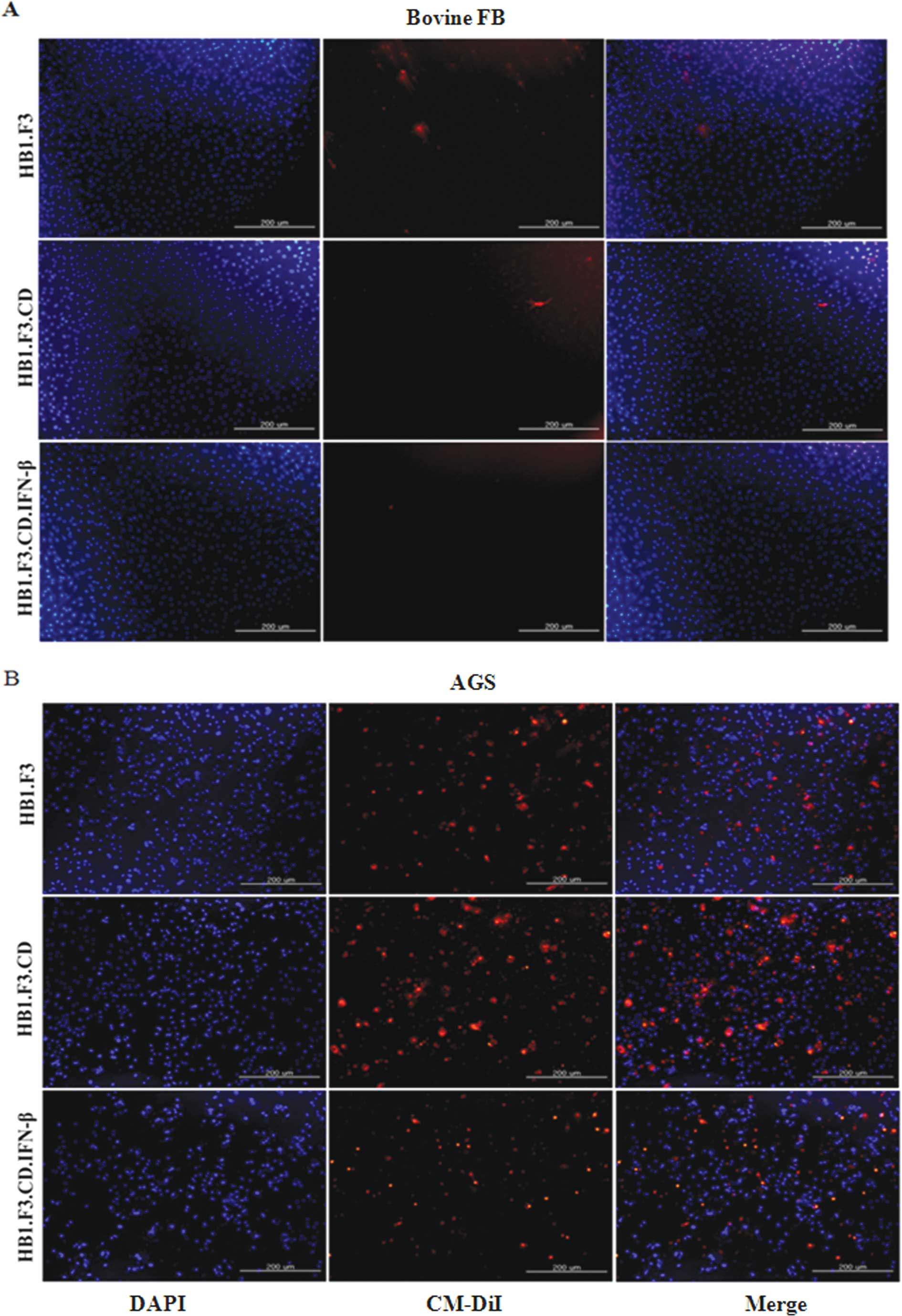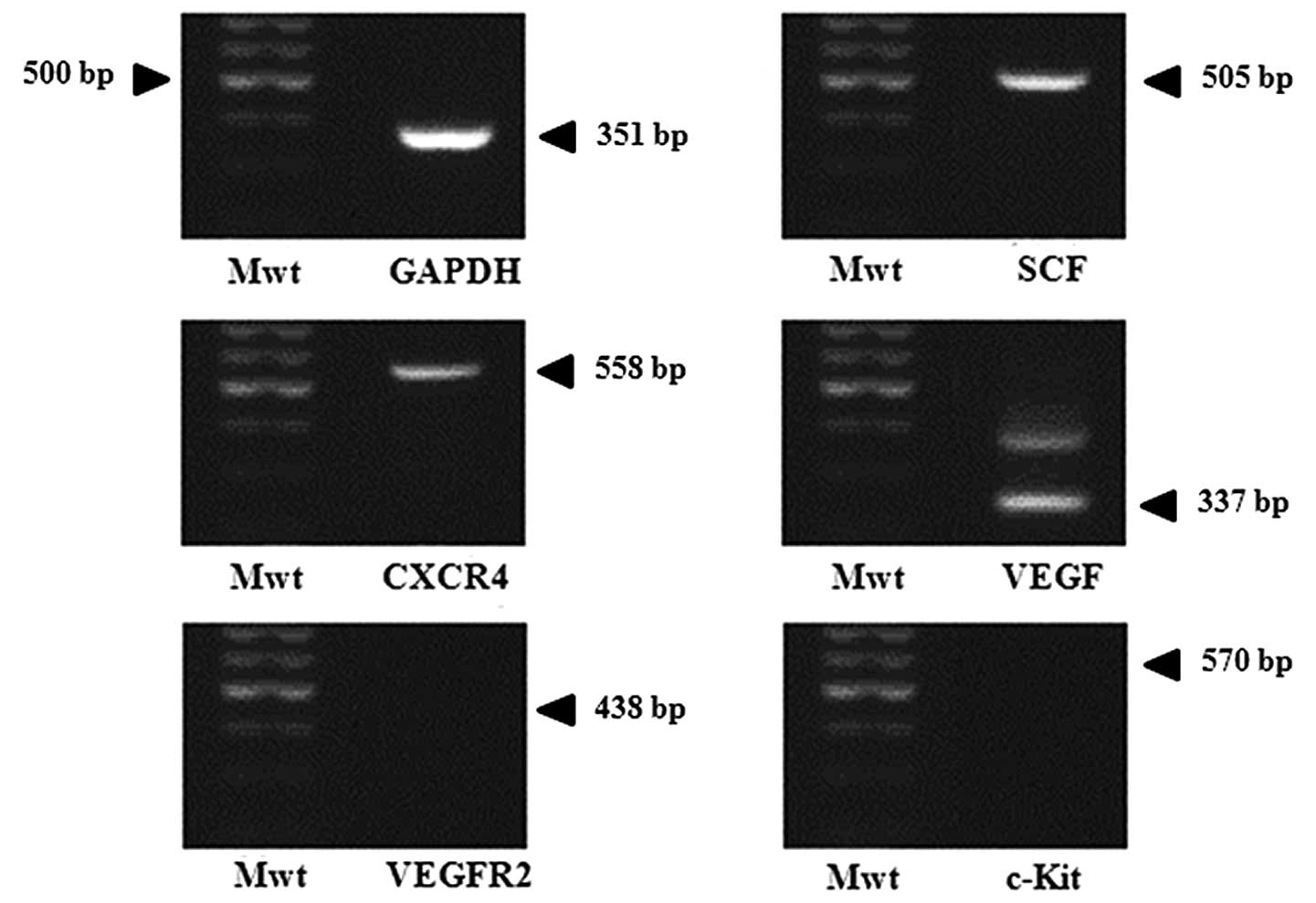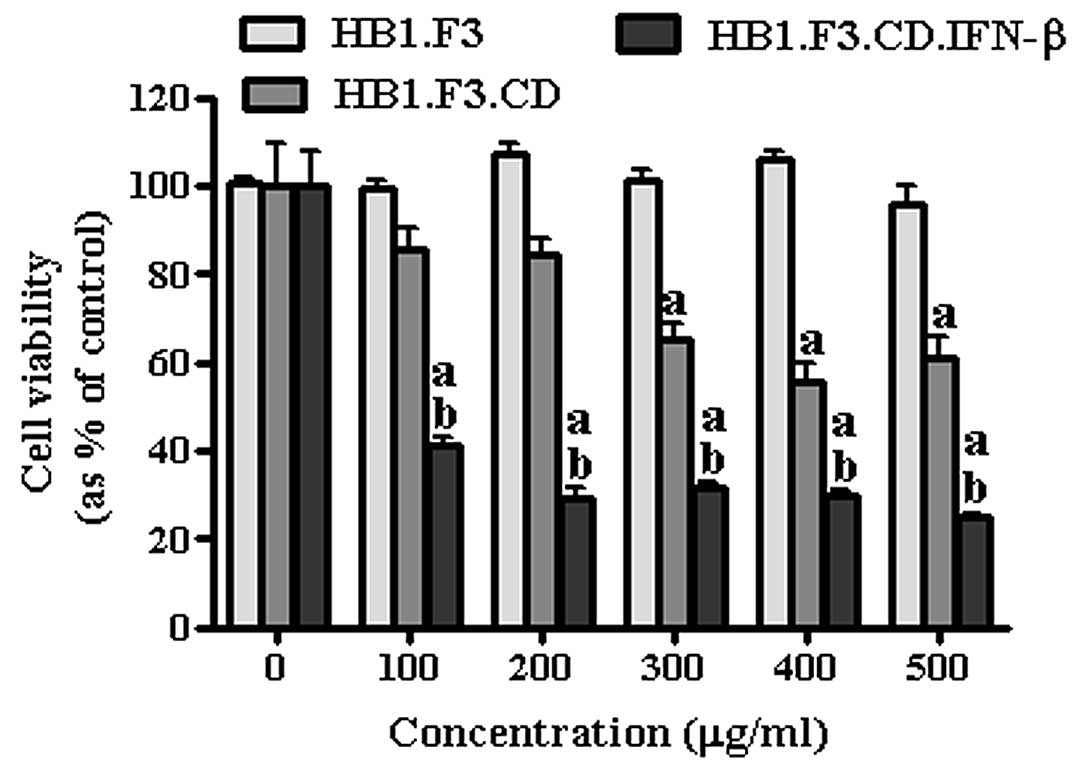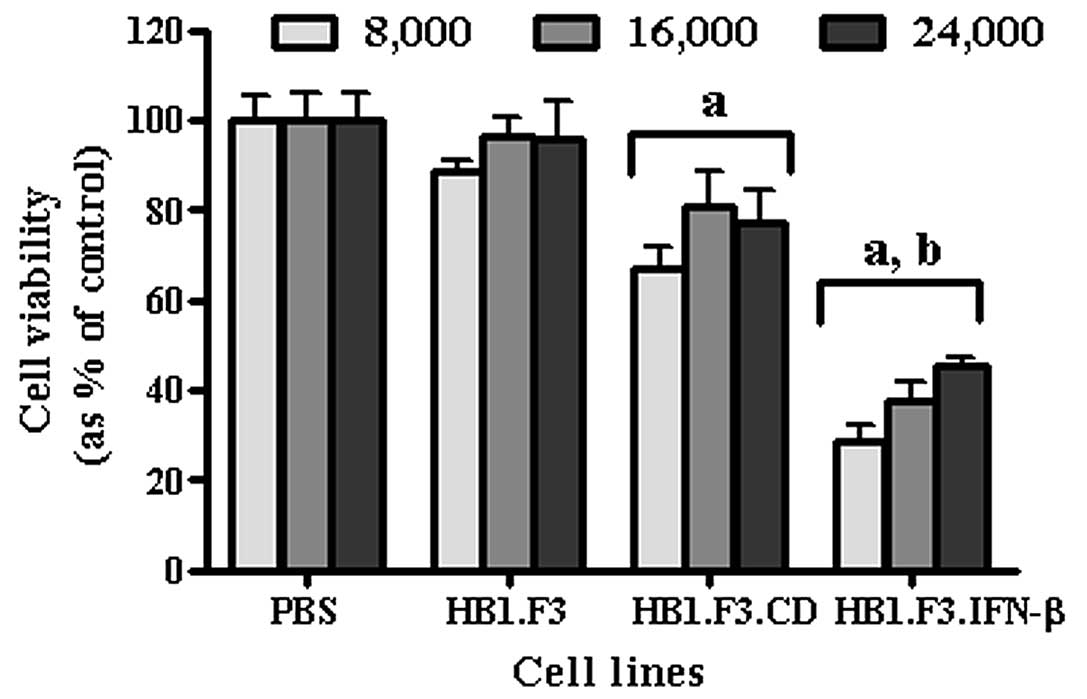|
1
|
Isik M, Caner S, Metin Seker M, et al:
Gastric adenocarcinoma under the age of 40; more metastatic, less
differentiated. J BUON. 16:253–256. 2011.PubMed/NCBI
|
|
2
|
Blum M, Suzuki A and Ajani JA: A
comprehensive review of S-1 in the treatment of advanced gastric
adenocarcinoma. Future Oncol. 7:715–726. 2011. View Article : Google Scholar : PubMed/NCBI
|
|
3
|
Fidan E, Fidan S, Yildiz B, et al: Bolus
fluorouracil induced syncope and pulseless ventricular tachycardia:
a case report. Hippokratia. 15:93–95. 2011.PubMed/NCBI
|
|
4
|
Longley DB, Harkin DP and Johnston PG:
5-Fluorouracil: mechanisms of action and clinical strategies. Nat
Rev Cancer. 3:330–338. 2003. View
Article : Google Scholar : PubMed/NCBI
|
|
5
|
Luo XR, Li JS, Niu Y and Miao L: Targeted
killing effects of double CD and TK suicide genes controlled by
survivin promoter on gastric cancer cell. Mol Biol Rep.
38:1201–1207. 2011. View Article : Google Scholar : PubMed/NCBI
|
|
6
|
Anderson LM, Krotz S, Weitzman SA and
Thimmapaya B: Breast cancer-specific expression of the Candida
albicans cytosine deaminase gene using a transcriptional
targeting approach. Cancer Gene Ther. 7:845–852. 2000.PubMed/NCBI
|
|
7
|
Joo KM, Park IH, Shin JY, et al: Human
neural stem cells can target and deliver therapeutic genes to
breast cancer brain metastases. Mol Ther. 17:570–575. 2009.
View Article : Google Scholar : PubMed/NCBI
|
|
8
|
Studeny M, Marini FC, Champlin RE,
Zompetta C, Fidler IJ and Andreeff M: Bone marrow-derived
mesenchymal stem cells as vehicles for interferon-β delivery into
tumors. Cancer Res. 62:3603–3608. 2002.
|
|
9
|
Zhang JF, Wei F, Wang HP, et al: Potent
anti-tumor activity of telomerase-dependent and HSV-TK armed
oncolytic adenovirus for non-small cell lung cancer in vitro and in
vivo. J Exp Clin Cancer Res. 29:522010. View Article : Google Scholar : PubMed/NCBI
|
|
10
|
Aboody KS, Brown A, Rainov NG, et al:
Neural stem cells display extensive tropism for pathology in adult
brain: evidence from intracranial gliomas. Proc Natl Acad Sci USA.
97:12846–12851. 2000. View Article : Google Scholar : PubMed/NCBI
|
|
11
|
Aboody KS, Bush RA, Garcia E, et al:
Development of a tumor-selective approach to treat metastatic
cancer. PLoS One. 1:e232006. View Article : Google Scholar : PubMed/NCBI
|
|
12
|
Kim SK, Kim SU, Park IH, et al: Human
neural stem cells target experimental intracranial medulloblastoma
and deliver a therapeutic gene leading to tumor regression. Clin
Cancer Res. 12:5550–5556. 2006. View Article : Google Scholar
|
|
13
|
Kim KY, Kim SU, Leung PC, Jeung EB and
Choi KC: Influence of the prodrugs 5-fluorocytosine and CPT-11 on
ovarian cancer cells using genetically engineered stem cells:
tumor-tropic potential and inhibition of ovarian cancer cell
growth. Cancer Sci. 101:955–962. 2010. View Article : Google Scholar : PubMed/NCBI
|
|
14
|
Kim SU: Human neural stem cells
genetically modified for brain repair in neurological disorders.
Neuropathology. 24:159–171. 2004. View Article : Google Scholar : PubMed/NCBI
|
|
15
|
Kim SU, Nakagawa E, Hatori K, Nagai A, Lee
MA and Bang JH: Production of immortalized human neural crest stem
cells. Methods Mol Biol. 198:55–65. 2002.PubMed/NCBI
|
|
16
|
Evoy D, Hirschowitz EA, Naama HA, et al:
In vivo adenoviral-mediated gene transfer in the treatment of
pancreatic cancer. J Surg Res. 69:226–231. 1997. View Article : Google Scholar : PubMed/NCBI
|
|
17
|
Hirschowitz EA, Ohwada A, Pascal WR, Russi
TJ and Crystal RG: In vivo adenovirus-mediated gene transfer of the
Escherichia coli cytosine deaminase gene to human colon
carcinoma-derived tumors induces chemosensitivity to
5-fluorocytosine. Hum Gene Ther. 6:1055–1063. 1995.PubMed/NCBI
|
|
18
|
Kanai F, Lan KH, Shiratori Y, et al: In
vivo gene therapy for α-fetoprotein-producing hepatocellular
carcinoma by adenovirus-mediated transfer of cytosine deaminase
gene. Cancer Res. 57:461–465. 1997.
|
|
19
|
Lan KH, Kanai F, Shiratori Y, et al:
Tumor-specific gene expression in carcinoembryonic antigen -
producing gastric cancer cells using adenovirus vectors.
Gastroenterology. 111:1241–1251. 1996. View Article : Google Scholar : PubMed/NCBI
|
|
20
|
Li Z, Shanmugam N, Katayose D, et al:
Enzyme/prodrug gene therapy approach for breast cancer using a
recombinant adenovirus expressing Escherichia coli cytosine
deaminase. Cancer Gene Ther. 4:113–117. 1997.PubMed/NCBI
|
|
21
|
Austin EA and Huber BE: A first step in
the development of gene therapy for colorectal carcinoma: cloning,
sequencing, and expression of Escherichia coli cytosine
deaminase. Mol Pharmacol. 43:380–387. 1993.PubMed/NCBI
|
|
22
|
Mullen CA, Kilstrup M and Blaese RM:
Transfer of the bacterial gene for cytosine deaminase to mammalian
cells confers lethal sensitivity to 5-fluorocytosine: a negative
selection system. Proc Natl Acad Sci USA. 89:33–37. 1992.
View Article : Google Scholar : PubMed/NCBI
|
|
23
|
Etienne MC, Cheradame S, Fischel JL, et
al: Response to fluorouracil therapy in cancer patients: the role
of tumoral dihydropyrimidine dehydrogenase activity. J Clin Oncol.
13:1663–1670. 1995.PubMed/NCBI
|
|
24
|
Pinedo HM and Peters GF: Fluorouracil:
biochemistry and pharmacology. J Clin Oncol. 6:1653–1664.
1988.PubMed/NCBI
|
|
25
|
Chung-Faye GA, Chen MJ, Green NK, et al:
In vivo gene therapy for colon cancer using adenovirus-mediated,
transfer of the fusion gene cytosine deaminase and uracil
phosphoribosyltransferase. Gene Ther. 8:1547–1554. 2001. View Article : Google Scholar
|
|
26
|
Crystal RG, Hirschowitz E, Lieberman M, et
al: Phase I study of direct administration of a replication
deficient adenovirus vector containing the E. coli cytosine
deaminase gene to metastatic colon carcinoma of the liver in
association with the oral administration of the pro-drug
5-fluorocytosine. Hum Gene Ther. 8:985–1001. 1997.PubMed/NCBI
|
|
27
|
Freytag SO, Khil M, Stricker H, et al:
Phase I study of replication-competent adenovirus-mediated double
suicide gene therapy for the treatment of locally recurrent
prostate cancer. Cancer Res. 62:4968–4976. 2002.
|
|
28
|
Dong Z, Greene G, Pettaway C, et al:
Suppression of angiogenesis, tumorigenicity, and metastasis by
human prostate cancer cells engineered to produce interferon-β.
Cancer Res. 59:872–879. 1999.PubMed/NCBI
|
|
29
|
Rossiello F, De Cicco Nardone F and
Dell’Acqua S: Interferon-β increases the sensitivity of endometrial
cancer cells to cell-mediated cytotoxicity. Gynecol Oncol.
54:130–136. 1994.
|
|
30
|
Yi BR, Hwang KA, Kang NH, Kim SU, Jeung EB
and Choi KC: Antitumor therapeutic effects of cytosine deaminase
and interferon-β against endometrial cancer cells using genetically
engineered stem cells in vitro. Anticancer Res. 31:2853–2862.
2011.
|
|
31
|
Yi BR, O SN, Kang NH, et al: Genetically
engineered stem cells expressing cytosine deaminase and
interferon-β migrate to human lung cancer cells and have
potentially therapeutic anti-tumor effects. Int J Oncol.
39:833–839. 2011.
|
|
32
|
Schmidt NO, Przylecki W, Yang W, et al:
Brain tumor tropism of transplanted human neural stem cells is
induced by vascular endothelial growth factor. Neoplasia.
7:623–629. 2005. View Article : Google Scholar : PubMed/NCBI
|
|
33
|
Sun L, Lee J and Fine HA: Neuronally
expressed stem cell factor induces neural stem cell migration to
areas of brain injury. J Clin Invest. 113:1364–1374. 2004.
View Article : Google Scholar : PubMed/NCBI
|
|
34
|
Ehtesham M, Yuan X, Kabos P, et al: Glioma
tropic neural stem cells consist of astrocytic precursors and their
migratory capacity is mediated by CXCR4. Neoplasia. 6:287–293.
2004. View Article : Google Scholar : PubMed/NCBI
|
|
35
|
Jeong SW, Chu K, Jung KH, Kim SU, Kim M
and Roh JK: Human neural stem cell transplantation promotes
functional recovery in rats with experimental intracerebral
hemorrhage. Stroke. 34:2258–2263. 2003. View Article : Google Scholar : PubMed/NCBI
|
|
36
|
Kim SU, Park IH, Kim TH, et al: Brain
transplantation of human neural stem cells transduced with tyrosine
hydroxylase and GTP cyclohydrolase 1 provides functional
improvement in animal models of Parkinson disease. Neuropathology.
26:129–140. 2006. View Article : Google Scholar
|
|
37
|
Meng XL, Shen JS, Ohashi T, Maeda H, Kim
SU and Eto Y: Brain transplantation of genetically engineered human
neural stem cells globally corrects brain lesions in the
mucopolysaccharidosis type VII mouse. J Neurosci Res. 74:266–277.
2003. View Article : Google Scholar : PubMed/NCBI
|
|
38
|
Rosser AE, Zietlow R and Dunnett SB: Stem
cell transplantation for neurodegenerative diseases. Curr Opin
Neurol. 20:688–692. 2007. View Article : Google Scholar : PubMed/NCBI
|
|
39
|
Ryu JK, Kim J, Cho SJ, et al: Proactive
transplantation of human neural stem cells prevents degeneration of
striatal neurons in a rat model of Huntington disease. Neurobiol
Dis. 16:68–77. 2004. View Article : Google Scholar : PubMed/NCBI
|
|
40
|
Lee ST, Chu K, Park JE, et al: Intravenous
administration of human neural stem cells induces functional
recovery in Huntington’s disease rat model. Neurosci Res.
52:243–249. 2005.PubMed/NCBI
|
|
41
|
Lee DH, Ahn Y, Kim SU, et al: Targeting
rat brainstem glioma using human neural stem cells and human
mesenchymal stem cells. Clin Cancer Res. 15:4925–4934. 2009.
View Article : Google Scholar : PubMed/NCBI
|
|
42
|
Boucher PD, Im MM, Freytag SO and Shewach
DS: A novel mechanism of synergistic cytotoxicity with
5-fluorocytosine and ganciclovir in double suicide gene therapy.
Cancer Res. 66:3230–3237. 2006. View Article : Google Scholar : PubMed/NCBI
|
|
43
|
Hartmann KU and Heidelberger C: Studies on
fluorinated pyrimidines. XIII. Inhibition of thymidylate
synthetase. J Biol Chem. 236:3006–3013. 1961.PubMed/NCBI
|
|
44
|
Wei J, Wahl J, Knauss H, et al: Cytosine
deaminase/5-fluorocytosine gene therapy and Apo2L/TRAIL cooperate
to kill TRAIL-resistant tumor cells. Cancer Gene Ther. 14:640–651.
2007. View Article : Google Scholar : PubMed/NCBI
|
|
45
|
Huber BE, Austin EA, Richards CA, Davis ST
and Good SS: Metabolism of 5-fluorocytosine to 5-fluorouracil in
human colorectal tumor cells transduced with the cytosine deaminase
gene: significant antitumor effects when only a small percentage of
tumor cells express cytosine deaminase. Proc Natl Acad Sci USA.
91:8302–8306. 1994. View Article : Google Scholar
|
|
46
|
Saukkonen K and Hemminki A:
Tissue-specific promoters for cancer gene therapy. Expert Opin Biol
Ther. 4:683–696. 2004. View Article : Google Scholar
|
|
47
|
Tubiana M: Tumor cell proliferation
kinetics and tumor growth rate. Acta Oncol. 28:113–121. 1989.
View Article : Google Scholar : PubMed/NCBI
|
|
48
|
Beppu K, Jaboine J, Merchant MS, Mackall
CL and Thiele CJ: Effect of imatinib mesylate on neuroblastoma
tumorigenesis and vascular endothelial growth factor expression. J
Natl Cancer Inst. 96:46–55. 2004. View Article : Google Scholar : PubMed/NCBI
|
|
49
|
Sun L, Hui AM, Su Q, et al: Neuronal and
glioma-derived stem cell factor induces angiogenesis within the
brain. Cancer Cell. 9:287–300. 2006. View Article : Google Scholar : PubMed/NCBI
|
|
50
|
Nakamizo A, Marini F, Amano T, et al:
Human bone marrow-derived mesenchymal stem cells in the treatment
of gliomas. Cancer Res. 65:3307–3318. 2005.PubMed/NCBI
|




















